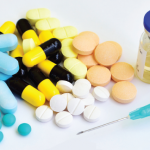Introduction & Objectives
Over the past two decades since biologic disease-modifying anti-rheumatic drugs (DMARDs) were first approved by the U.S. Federal Drug Administration (FDA), they have improved the health and productivity of many patients with moderate-to-severe rheumatoid arthritis, psoriasis/psoriatic arthritis, ankylosing spondylitis, lupus, systemic vasculitis and other rheumatic and autoimmune diseases, which together affect more than 1 million Medicare beneficiaries. However, due to their high prices ($22,000–44,000 per patient annually) and placement in specialty tiers with high levels of cost-sharing, biologic DMARDs pose substantial financial burdens for patients and taxpayers.
Three biologic agents (adalimumab, etanercept and infliximab) have been ranked among the top five prescription medications in the U.S. for the greatest total spending.
Billions of public dollars are spent each year on biologic DMARDs, but the drivers of recent increases in biologic DMARD spending are unclear. This study was undertaken to characterize changes in total spending and unit prices for biologic DMARDs used in the treatment of rheumatic diseases in Medicare and Medicaid programs and quantify the major sources of these spending increases.
Methods
The authors accessed drug spending data from 2012–16 for Medicare Part B (fee-for-service), Medicare Part D and Medicaid enrollees. After calculating five-year changes in total spending and unit prices for each biologic DMARD, as well as in aggregate, the researchers performed standard decomposition analyses to isolate four sources of spending growth: drug prices, uptake (number of recipients), treatment intensity (mean number of doses per claim), and treatment duration (annual number of claims per recipient), both excluding and including time-varying rebates.
Results
From 2012 to 2016, annual spending on public-payer claims for the 10 biologic DMARDs included in this study more than doubled ($3.8 billion to $8.6 billion), with median drug price increases of 51% in Medicare Part D (mean 54%) and 8% in Medicare Part B (mean 21%). With adjustment for general inflation, unit price increases alone accounted for 57% of the five-year, $3.0 billion spending increase in Part D, while 37% of the spending increase was from increased uptake. Accounting for time-varying rebates, prices were still responsible for 54% of increased spending. Unit prices and spending were lower under Medicaid than under Medicare Part D, though temporal trends and contributors were similar.
Conclusion
Postmarket drug price changes alone account for the majority of the recent spending growth in biologic DMARDs.
The recent introduction of biosimilars could foster more competition and lower prices in theory, but as of August 2019, only two of nine FDA-approved DMARD biosimilars (infliximab-dyyb and infliximab-abda) were being marketed in the U.S.
Policy interventions targeting price increases, particularly those under Medicare Part D plans, may help mitigate financial burdens for public payers and biologic DMARD recipients.
Refer to the full study for all source material.
Excerpted and adapted from:
McCormick N, Wallace ZS, Sacks CA, et al. Decomposition analysis of spending and price trends for biologic antirheumatic drugs in Medicare and Medicaid. Arthritis Rheumatol. 2020 Feb;72(2):234–241.


